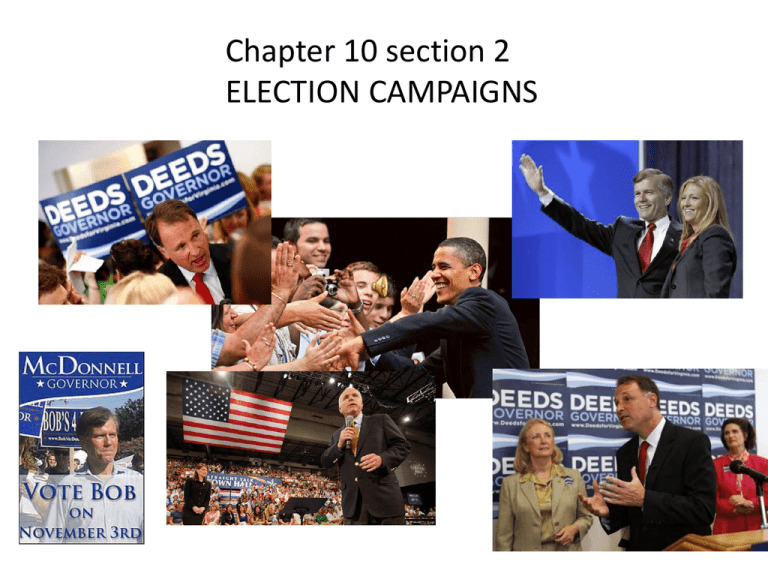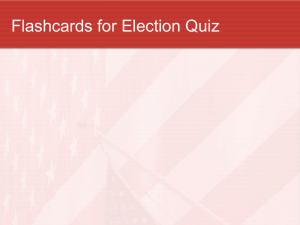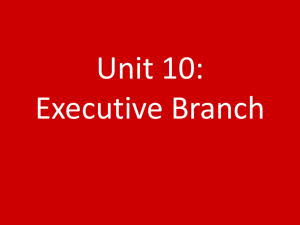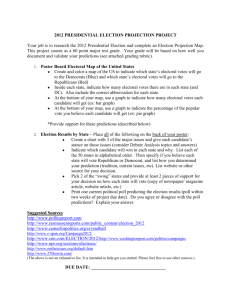A. Primary Election
advertisement

Chapter 10 section 2 ELECTION CAMPAIGNS 1. Types of Elections: A. Primary Election – narrows the field of candidates B. General Election – Chooses the person to fill the office. C. Special Election – run-off election : no candidate has won a majority Recall election – vote to remove an official from office II. New laws at election time. A. Voters can propose new laws through a process known as the Initiative. B. They get signatures of qualified voters on a petition. C. The proposed law is called a proposition and is placed on the ballot in the next general election. D. Citizens can approve or reject state or local laws through referendum votes III. Steps to Presidential Elections. 1. Nomination of candidates: Step 1: Candidates campaign to win their party’s nomination. Step 2. Primary elections are held to reduce the number of Candidates Step 3: One candidate is chosen during the national convention 2. Campaigning Selected candidates travel across the country giving speeches and appearing on TV. 3. President is elected through the electoral college system. Popular Vote: Vote on the first Tuesday after the first Monday in November The winner of the popular vote for the state wins all of the electoral votes for that state Electoral vote: 270 out of 538 Vote on the Monday after the second Wednesday in December – Electors vote in their state capitals- the votes are sent to Congress January 6 – Electoral Votes officially counted by Congress January 20thPresident is sworn into office IV. Electoral College System 1. When Americans cast their vote for President, they actually vote for an elector. A. Electors are pledged to cast their vote for their candidate. 1. Each state has as many electors as it has Senators and Representatives in the House of Representatives. Congressional Representation 2. Washington D.C. has 3 electoral votes. 3. The total number of electoral votes is 538 (100 + 435 + 3) 4. The Electoral college is the name given to all of the electors. 3.The popular vote (vote of the people) determines the electoral vote. A. It is a winner take all system – the candidate who wins the popular vote in a state receives all of that state’s electoral votes. 13 B. A candidate must have 270 out of the total 538 electoral votes to win the presidency. C. The electoral votes are officially counted on January 6 by Congress. 3. If no candidate receives a majority A. The House of Representatives chooses the President from the 3 leading candidates B. The Senate chooses the Vice President IV. Other Notes: A. Straight Ticket: when a person votes for candidates from one party on the same ballot Example: Republican President Republican Senator Republican Mayor •Split Ticket: when a person votes for candidates from different parties on the same ballot Example: Republican President Democrat Senator Republican Mayor C. Balanced Ticket: choosing a running mate with different characteristics from the candidate in order to get more votes. Quiet Reserved Family person Self made Good with details Religious Reaches older voters Outgoing Active Part of family business Charismatic Reaches younger voters 4. Lame Duck: an official who is still in office after his replacement has been chosen leaving the official with little or no power. Summary of the Presidential Election Process Candidates campaign to win their parties nomination Political parties hold primary elections between January and June to narrow down the field to one candidate Political parties hold a national convention to choose their candidate – Usually in Aug, Sept. Candidates campaign to hold the office General Election held on the first Tuesday after the first Monday to determine the popular vote. Popular voter determines the electoral vote. 270 needed Electors from each state meet in their state capitals and cast their votes for the president. The results are sent to Congress. December. Congress counts the votes from the electors on Jan. 6 and announce the winner. The new president is sworn into office on Jan 20.






